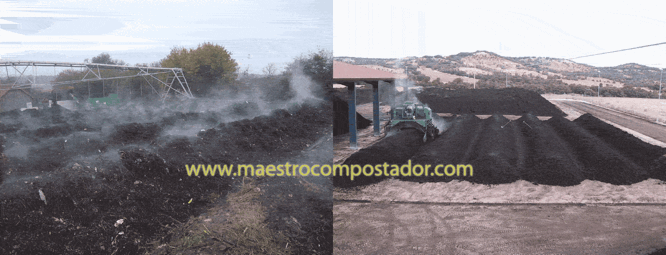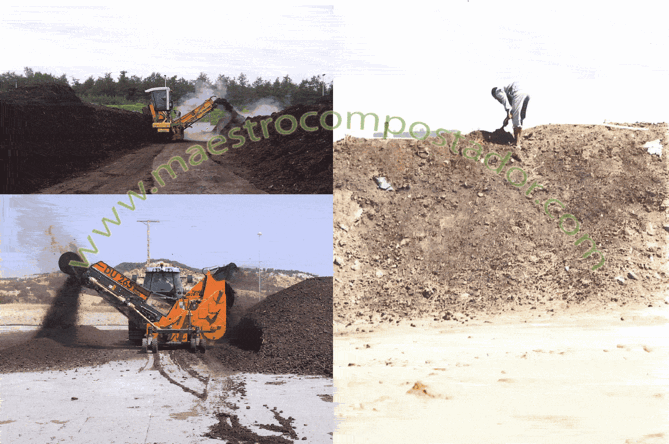Open systems
Are the most primitive ones but not the less efficient. Usually they are use to be low cost systems and simple technology, applicable mainly in small or medium size communities of zones where there is a high land availability, mostly rural or semi-rural areas. The weather conditions of the area can be decisive, limiting much this influence with simple covers without walls that would imply a justified increase of the costs of the installation. In some cases, looking for a cheaper solution, only the maturation area or part of it is covered, with the purpose of avoiding excessive moisture of the material in phases next to the final sifting. The form of accumulation of the material in this type of facilities is varied (windrows, table heaps, piles, etc…), as well as the ways of processing them. Most usual it is to use dynamic systems, using specific devices (turners) or unspecific machinery (front loaders). They are littler those than show preference for static methods. Usually this is because there is a lack of space and/or appropriate machinery in the installation.
Windrow composting
It was Sir. Albert Howard who at the 1930’s implemented the traditional composting methods with piles to long windrows of green and animal wastes. Since here they became the classic composting system and have been the base to forthcoming developments. In this system we can find two varieties: dynamic and static windrows. In the case of dynamic windrows the only way to control temperature it is the combination of turnings and waterings, or to play with its size. To control temperature in static windrows, the Rutgers method is used with a forced ventilation system using pipes buried in the material or in narrow trenches made in the ground under the windrow. If the process control is realized by the oxygen levels, the Beltsville method would be the most adequate one, although the usual is to find methods with the combination of both, alternating ventilation periods of time with force aeration blowing with aeration by aspiration.

The dynamic windrows have the advantage of achieve a higher homogenization of the material, a mechanical diminish of the particle mean size that contributes to obtain a higher volume diminish and, finally, a higher material hygienization because all the material passes through thermophyle phases after some turnings. Unfortunately, they presented the big difficult for controlling the temperature, possible problems of deficient oxygenation in deep layers if the structure is not the adequate one (it could not be guaranteed by the turnings) and the expensive price of the turners
Table heaps composting
It is a windrow variant from a triangular section to another trapezoidal one that allows a big width base similar to a lateral union of too many windrows. The main advantage is a better surface use (higher number of m3 by m2 of occupied surface) and a higher retention capacity of generated heat by the microbiota metabolism, which reinforces the system capacity to have the possibility to be employed as open system in extreme environments, from cold and moisture ones to hot and desert ones, because it also allows a higher material moisture retention.

Trenchs composting
It is one of the variants of the Sir Horwards' Indore method. In certain way there would be negative level windrows, where the material to compost is situated into niches or holes practiced in the soil. There are uncommon systems only appropriated for very host and dry climates or for some very specific cases. Its main advantage is to maximize as well irrigation water as rainfall, but the possibility to anaerobiosis risks increase. In some cases they are used thanks to the land worms action, with the double function of soil retention for erosion due to watering and additional fertilization, but there are always Indore method variants, like it is the case of the Mazibuko method developed in South Africa for recovering very degraded soils.


